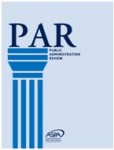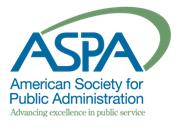Widgetized Section
Go to Admin » Appearance » Widgets » and move Gabfire Widget: Social into that MastheadOverlay zone
Public Administration Review
 |
Public Administration Review © American Society for Public Administration
PAR Preview is a monthly newsletter that calls attention to forthcoming articles in PAR. PAR Preview provides brief summaries of content now available digitally in Early View, Wiley’s online publication system. |
Perspective
A Remembrance of Luther Gulick
Scott Fosler (University of Maryland) and Dwight Ink remember Luther Gulick as an American visionary pragmatist. His contributions to government covered so many arenas and eras that people are constantly surprised when yet another one pops into view. Link to PAR Early View
Perspective
Remembering William Mosher: A Pioneer of Public Administration
Jeremy F. Plant (Penn State Harrisburg) remembers the first dean of the Maxwell School of Citizenship and Public Affairs at Syracuse University. In his day, William Mosher was a well-regarded scholar in the area of personnel management. Today he is better known for two lasting contributions that continue to resonate: the development of the master of public administration (MPA) curriculum and the creation of the American Society for Public Administration (ASPA). Link to PAR Early View
Perspective
Administering Dodd-Frank: Unfinished Business from the Financial Crisis
Thomas H. Stanton (Johns Hopkins University) asserts that the major unfinished business from the financial crisis relates to public administration: trying to implement effective supervision of banks, and especially big banks. Only with boots on the ground can financial regulators try to ensure that an institution accurately detects and addresses major vulnerabilities in the way it does business. Link to PAR Early View
Perspective
The Limits of Transparency
Amitai Etzioni (George Washington University) discusses how transparency has long been a popular way of governing in the United States. Recent ideological and political developments have further enhanced its popularity. However, Etzioni asserts that transparency is a very poor substitute for regulation. True, regulation poses costs and raises normative issues of its own, hence it is best used sparingly. However, when there are compelling reasons to advance a particular common good—say, climate control or public health—transparency can help regulation but cannot replace it. Link to PAR Early View
Research Article
Public Service Motivation Concepts and Theory: A Critique
With its growth in popularity, public service motivation (PSM) research has been subjected to increasing critical scrutiny, but with more focus on measurement and models than on concepts. Barry Bozeman (Arizona State University) and Xuhong Su (University of South Carolina) examine PSM against standard criteria for judging the strength of concepts (e.g., resonance, parsimony, differentiation, and depth). After providing a critique of PSM concepts, they conclude with suggestions for research programs that could improve the explanatory power of PSM theory. Link to PAR Early View
Research Article
Good Governance Practices in Professional Associations for Public Employees: Evidence of a Public Service Ethos?
Professional associations and occupational societies play an important role in educating and credentialing public employees. Very little research has attempted to connect, empirically, a public service ethos to the professional memberships that public employees carry. Nowhere is that potential influence more likely to be seen than in the governing boards of these nonprofit associations, whose behavior is subject to strong normative and mimetic influences as a result of the public’s expectations for good governance. Beth Gazley (Indiana University Bloomington) uses a large generalizable sample of boards of directors, controlling for many organizational characteristics known to influence board behavior, to compare the governance practices of professional and trade associations serving public employees with those serving the private sector. Results suggest that governance practices are shaped by many forces but that public employees do indeed carry their public values into the associations they join, and these values, in turn, are positively related to board behavior. Link to PAR Early View
Research Article
The Boston Marathon Bombings: Who’s to Blame and Why It Matters for Public Administration
John D. Marvel (George Mason University) examines how elite attributions of blame—statements from politicians and high-level public administrators assigning responsibility for failure to prevent the Boston Marathon bombings—affect citizens’ beliefs regarding which government organizations, if any, are culpable for failing to prevent the bombings. The primary hypothesis is that public administrators, owing to their greater credibility relative to politicians, will more strongly influence citizens’ notions of who is to blame. Findings show that public administrators are viewed as significantly more credible among Democrats, and this credibility advantage translates into influence. Additionally, blame statements implicating the Federal Bureau of Investigation for failing to prevent the Boston Marathon bombings are particularly influential among Republicans, and exculpatory statements are particularly influential among Democrats. As discussed in the context of the Boston Marathon bombings, the public process of attributing blame for a perceived governmental failure has important implications for public administration. Link to PAR Early View
|
Public Administration Review is published by Wiley on behalf of the American Society for Public Administration. Editor-in-Chief: James L. Perry ▪ Managing Editor: Richard Feiock For any comments or inquiries regarding PAR, please contact us at [email protected]. |
 |
|
Follow us on Twitter (@PAReview) and also on Facebook.
|
|
|
For Table of Contents (TOC) alerts, please follow the instructions below:
|
|
